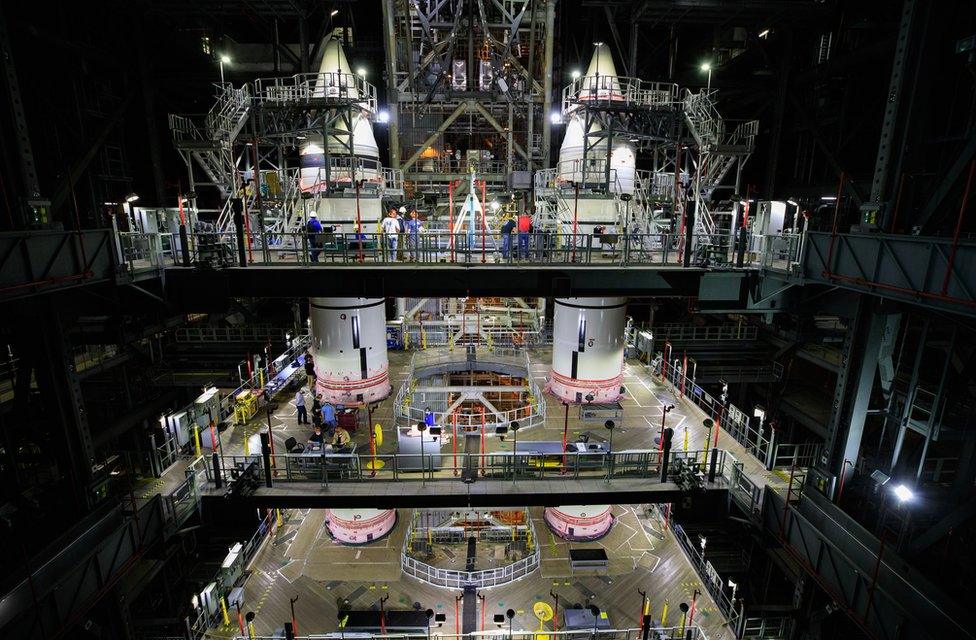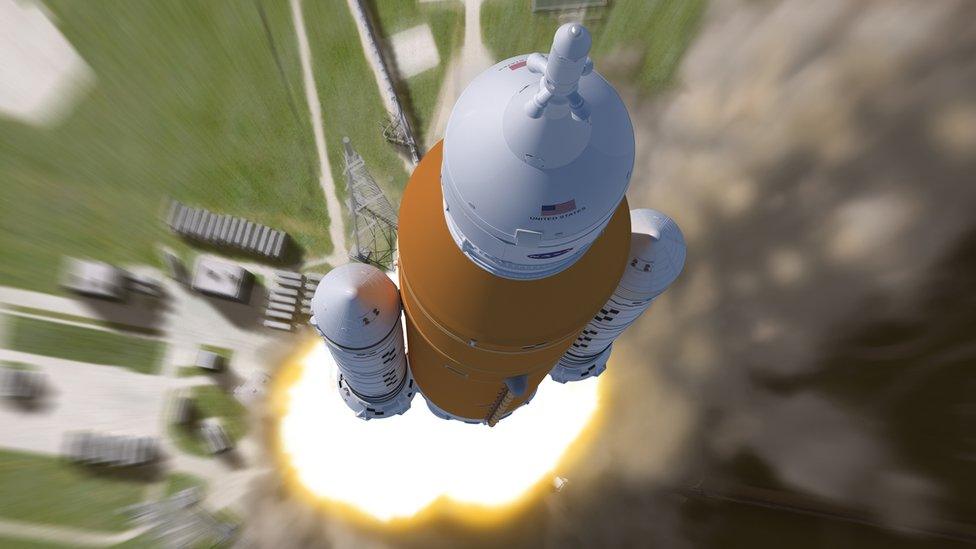SLS: Nasa assembles twin boosters for its 'megarocket'
- Published

Engineers have finished assembling the twin solid rocket boosters
Nasa has completed the assembly of two booster rockets that will help power its gigantic, next-generation launch system - the SLS.
The SLS, or Space Launch System, is the rocket that will return astronauts to the Moon under the US Artemis project.
Over the course of several months, workers at Florida's Kennedy Space Center have vertically stacked the booster rockets' 10 segments.
When operational, the SLS will be the most powerful rocket in the world.
It will be capable of producing up to 8.8 million pounds of thrust, making it 15% more powerful than the Saturn V rocket that lofted the Apollo lunar missions.
The SLS consists of a huge core stage with four powerful engines at its base and the two solid rocket boosters (SRBs) attached on either side.
The two completed SRBs at Kennedy Space Center will fly on the maiden launch of the SLS - known as Artemis 1 - which is scheduled for late 2021.
Each identical booster is divided into five segments bookended by large rocket pieces known as the forward and aft assemblies.

Artwork: How the SLS will look during its ascent
The SRBs have been stacked on a structure called the mobile launcher, which will support the testing, checkout and servicing of the SLS, as well as transfer it to the launch pad at Kennedy Space Center.
The boosters, which are similar to the ones that helped launch the now-retired space shuttle, will provide 75% of total thrust at lift-off.
On Twitter, Charles Precourt, vice president for propulsion systems at Northrop Grumman - which manufactures the SRBs - said it was "exciting to see fully stacked boosters".
Engineers with Nasa's Exploration Ground Systems team positioned the first segment on 21 November 2020, and continued the process until the final nose assembly was added on 2 March this year.
"Stacking the solid rocket boosters is a huge milestone," said senior vehicle operations manager Cliff Lanham. "It means the rocket is being assembled on the mobile launcher and we are in the final stages of a long journey - getting to launch Artemis 1."
The SLS has the necessary thrust to propel Nasa's next-generation crew vehicle, Orion, to the Moon without it first having to dock with a separate propulsion stage in Earth orbit.
America is returning to the Moon under the Artemis programme (named after Apollo's sister in Greek mythology). The project was initiated under Donald Trump's presidency; but in February, the Biden administration backed the Moon shot.
The four main engines were fired in unison for the first time, but had to be shut down early
The Trump White House had set an aggressive target date of 2024 for the US space agency to perform the the first human landing on the Moon since 1972. However, the Biden administration has made no mention of this timeline, leading to speculation that the date will slip.
The final large piece of the SLS waiting to be slotted in on the mobile launcher is the orange-coloured core stage, which is currently undergoing evaluation at Nasa's Stennis Space Center near Bay St Louis, Mississippi.
Nasa plans to carry out a "hotfire" test of the core in mid-March, which will involve igniting all four engines. Engineers are aiming to fire them for the full eight minutes that it takes for the SLS to reach space.
During the first attempt at a hotfire in January, an issue with the core stage hydraulics caused the test to end after only a minute.
The maiden flight of the SLS is currently scheduled for late 2021. This will see the rocket launch an uncrewed Orion spacecraft on a trip around to Moon to conduct a full evaluation of both vehicles.
The joints that connect each segment of the solid rocket boosters have a limited lifespan of 12 months. The stacking of the boosters means that the clock is already ticking down to launch - although engineers have said there may be ways of extending the certification period.
Follow Paul on Twitter., external